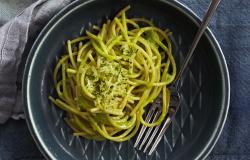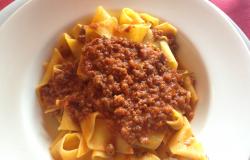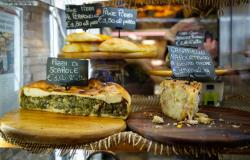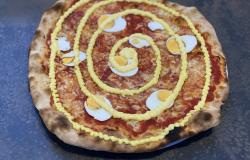Farro Tagliatelle with Shrimp and Fava Bean Pesto

Farro is an ancient grain that has been a staple food in Italy for centuries, especially during the the Roman Empire. It is grown in central and northern Italian regions and is almost always grown without chemical pesticides or fertilizers.
Farro is a term for three species: spelt, emmer and einkorn. Emmer is the most common variety grown in Italy and is regularly called “true” farro. Since farro is so low in gluten, it can often be eaten by people who have mild gluten sensitivity. Common Italian recipes include soups and salads made from the whole grains or breads, pastas and desserts made from farro flour.
Serves: 4-5
Attach the dough hook to the stand mixer. Add the flours and salt and mix on speed 1. Gradually add the beaten eggs and continue to mix for a few minutes, adding a tablespoon of water at a time, if needed, until the dough comes together in a ball. If the dough feels sticky to the touch, add a touch more flour. The right consistency is achieved when you can poke the dough and it leaves an imprint (like on a ripe peach) without the dough sticking to your finger. If you don’t have a stand mixer, follow the same procedure but knead by hand on a generously floured work space until the dough is homogenous, about 15 minutes. Wrap the dough in plastic wrap and place in the refrigerator for 30 minutes.
Bring a medium pot of water to boil, pour in the fava beans and cook for a 2-3 minutes. Drain and run them under cold water to lock in their bright green color. Shuck their outer skin and put the soft inside part of the fava bean in a food processor. Add the garlic, parsley, Parmigiano Reggiano, paprika, salt, pepper and a few tablespoons of extra virgin olive oil. Blend together, adding more extra virgin olive oil as necessary until it because a thick chunky pesto.
Roll the pasta out with the pasta roller attachment for the stand mixer, or with a rolling pin. Then use the tagliatelle attachment to cut the pasta or slice the noodles by hand with a knife so they are about 1/4 inch wide. Keep the noodles generously floured so they don’t stick together.
In a medium skillet add the extra virgin olive oil, white wine, shrimp and a few dashes of sweet paprika. Cook for 3-4 minutes over medium high heat or until the shrimp change from transparent to white. Remove the skillet from the heat.
In the meantime, bring a medium pot of water to boil. Add the coarse salt followed by the tagliatelle. Cook for 2-3 minutes then eat a noodle to see if it’s ready. The pasta should be “al dente” or slightly firm. If it is too firm, continue to cook for 1 minute and check again. Drain the pasta reserving a cup of the water.
Add the pasta to the shrimp along with the fava bean pesto. Stir well, adding a few spoonfuls of cooking water if needed to thin the sauce. Top with additional grated Parmigiano Reggiano cheese if desired. Buon appetito!






